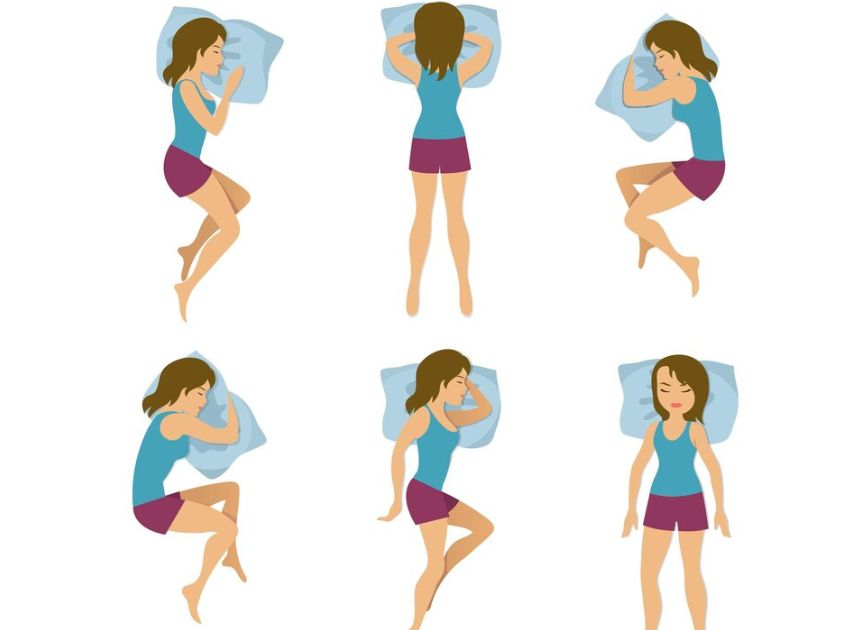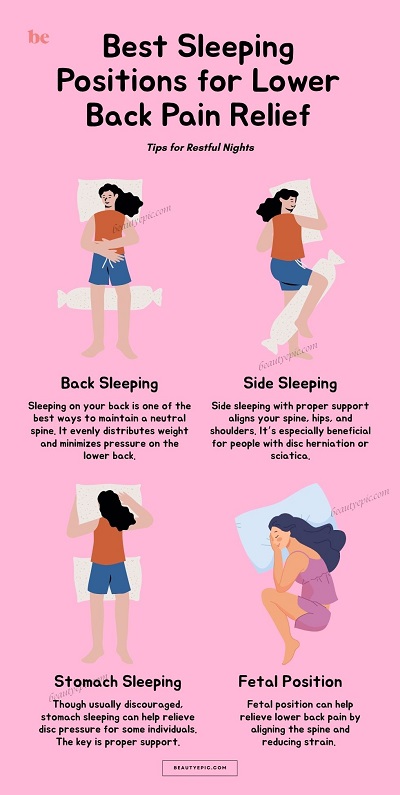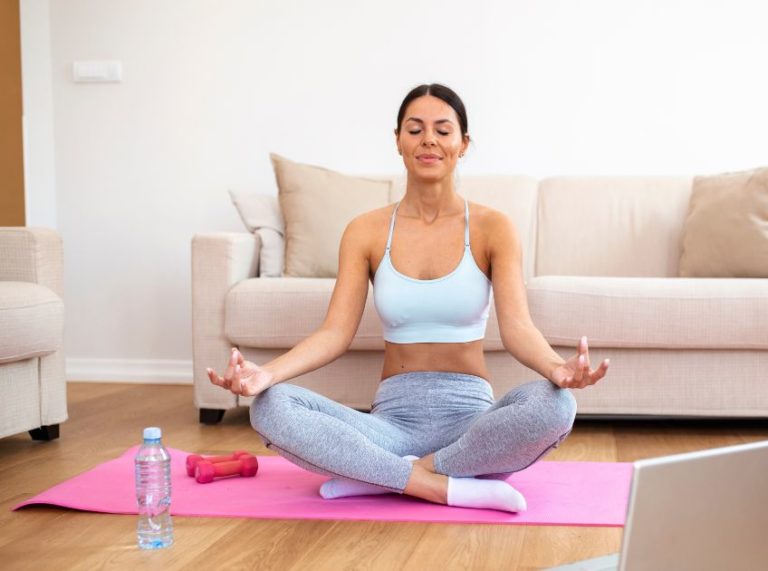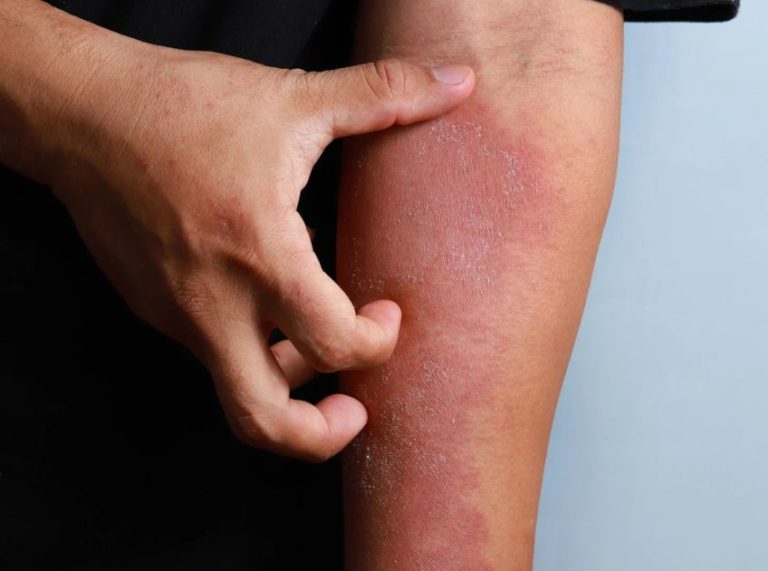
Important: This article is for informational purposes only. Please read our full disclaimer for more details.
Lower back pain is one of the most common complaints among adults, affecting sleep quality and overall well-being. While medications and therapies can offer temporary relief, your sleeping position plays a crucial role in managing and even reducing lower back pain. The right alignment during rest can ease muscle tension, decompress spinal discs, and help you wake up refreshed rather than stiff.
Let’s dive into the most effective sleeping positions that can offer lasting relief from lower back discomfort.
Why Sleep Posture Matters: How It Eases Lower Back Pain
Your spine is meant to rest in a natural curve. The wrong sleeping posture can flatten this curve, twist muscles, or compress nerves, exacerbating lower back issues. Sleeping correctly helps:
- Maintain spinal neutrality
- Evenly distribute body weight
- Reduce pressure on lumbar discs
- Improve circulation and healing
Clinical studies from the Journal of Biomechanics and Spine Journal confirm that neutral spine positioning during sleep reduces lumbar stress, especially in people with chronic lower back pain or disc issues (1).
1 . Side Sleeping: A Spine-Friendly Favorite
Why It Helps
Side sleeping with proper support aligns your spine, hips, and shoulders. It’s especially beneficial for people with disc herniation or sciatica.
Tips for Best Results
- Use a firm pillow between your knees to prevent pelvic rotation.
- Keep your knees slightly bent, not curled too tightly.
- Choose a medium-firm mattress that supports shoulder and hip pressure points.
Position Variant
Fetal Position – Curling into a loose fetal position can create more space between vertebrae, ideal for those with spinal disc compression. Alternate sides to avoid muscular imbalance.
2. Back Sleeping: The Gold Standard for Lumbar Support
Why It Helps
Sleeping on your back is one of the best ways to maintain a neutral spine. It evenly distributes weight and minimizes pressure on the lower back.
Tips for Best Results
- Place a small pillow or rolled towel under your knees to maintain the spine’s natural curve.
- Use a low-loft neck pillow to avoid straining your upper back.
- Avoid soft mattresses that allow the hips to sink.
Position Variant
Reclined Sleeping – Using an adjustable bed or wedge pillow to elevate your upper body can help reduce pressure on the lower spine. This works well for people with isthmic spondylolisthesis.
3. Stomach Sleeping: Least Recommended but Manageable
Why It Helps (Sometimes)
Though usually discouraged, stomach sleeping can help relieve disc pressure for some individuals. The key is proper support.
Tips for Best Results
- Place a thin pillow under your hips or lower abdomen to keep the spine aligned.
- Avoid thick neck pillows to reduce strain on the cervical spine.
- Stretch gently before and after sleep to reduce muscle stiffness.
Position Variant
Stomach Sleeping with Leg Raised – Bend one leg at the knee and bring it up toward the side while placing a pillow underneath. This hybrid position can alleviate lumbar tension.
4. Fetal Position: A Protective Curl for Disc Pain
Why It Helps
The fetal position gently opens up space between vertebrae, making it ideal for those with herniated discs or spinal stenosis. It reduces pressure on the spine and relaxes the joints in the lumbar area.
Tips for Best Results
- Lie on your side and gently curl your knees toward your chest.
- Avoid curling too tightly, which may strain your lower back and hips.
- Use a firm pillow between your knees for pelvic support.
Position Variant
Loose Fetal with Arm Support – Place a small pillow under the top arm or hug a body pillow to reduce shoulder and upper back tension.
Additional Sleep Tips for Lower Back Pain Relief
- Mattress Matters: A medium-firm mattress offers the best combination of support and pressure relief.
- Ergonomic Pillows: Choose pillows that support your natural sleep position—contour pillows work best for side and back sleepers.
- Stretch Before Bed: Gentle hamstring or pelvic tilts can help release lower back tension.
- Consistent Sleep Schedule: Poor sleep quality can increase pain sensitivity and muscle inflammation.
Science-Backed Insights on Sleep and Back Pain
According to a 2019 study in BMJ Open, individuals with poor sleep posture are more likely to experience chronic lumbar pain (2).
Another meta-analysis in The Lancet Rheumatology found that ergonomically optimized sleeping setups significantly reduce musculoskeletal discomfort in the lumbar region (3).
This reinforces the importance of combining the right posture, mattress, and pillow for optimal back health.
Frequently Asked Questions (FAQ’S)
1. What is the single best sleeping position for lower back pain?
A. Sleeping on your back with a pillow under the knees is often considered the best for maintaining spinal alignment and reducing lower back pressure.
2. Can a bad mattress cause lower back pain even if I use the right position?
A. Yes. A saggy or too-soft mattress can misalign your spine, even in the best posture. A supportive mattress is essential for proper positioning.
3. How long will it take to feel relief after adjusting my sleeping position?
A. It varies by individual, but many people notice improvement within 1–2 weeks of consistently using an optimal sleep position and proper support.
Final Thoughts
Quality sleep isn’t just about how long you rest—it’s about how you position your body during that rest. Whether you’re a side sleeper, back sleeper, or occasional stomach sleeper, slight adjustments like using supportive pillows or elevating your knees can make a world of difference.
Try the tips above and give your lower back the support it deserves—every night.
















